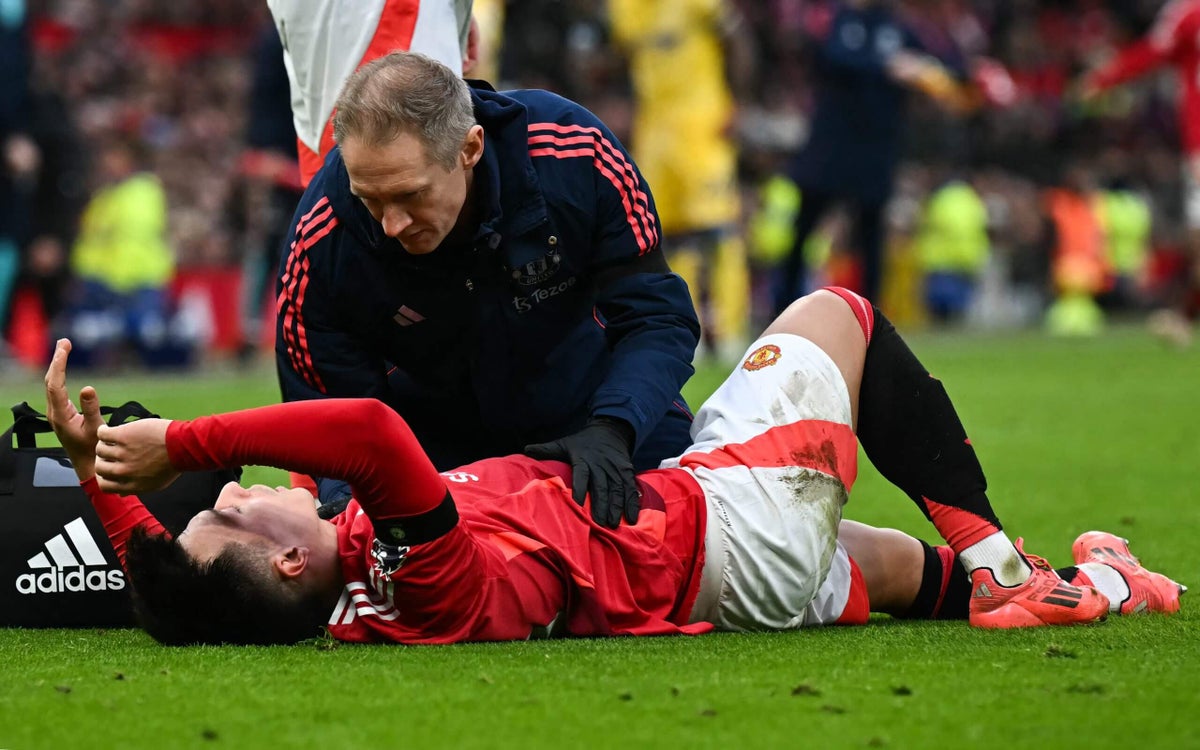
Premier League ACL injuries: Examining the scale and causes of this season’s ‘epidemic’
- Sports
- February 14, 2025
- No Comment
- 181
Anterior cruciate ligament injuries.
They are four words that strike dread into the hearts of footballers at every level and, at the Premier League level, they are being heard more frequently than ever. In fact, this season is on course for a record number of ACLs since injury data began.
According to Ben Dinnery, head of injury analyst website Premier Injuries, there have been 10 ACL injuries in England’s top flight so far this season, putting the league on course for a record number in 2024-25.
This year alone, there have been seven ACL injuries, most recently Manchester United defender Lisandro Martinez.
For context, the average number across the six seasons between 2017-18 and 2022-23 is just 6.3; between 2012-13 (when Premier Injuries’ data collection began) and 2016-17, the average was 10.4. As it stands, the Premier League is on track to end the campaign with 13. There have been 20 recorded incidents to WSL players since January 2024, according to Premier Injuries.
This is a breakdown of Premier League players who have suffered an ACL injury this season:
Premier League players with ACL injuries this season
| Player | Club | When sustained | How sustained |
|---|---|---|---|
|
Yerson Mosquera |
Wolves |
September |
Club match |
|
Rodri |
Manchester City |
September |
Club match |
|
Abdul Fatawu |
Leicester City |
November |
International match |
|
Enes Unal |
Bournemouth |
January |
Training |
|
Gabriel Jesus |
Arsenal |
January |
Club match |
|
Chadi Riad |
Crystal Palace |
January |
Training |
|
Orel Mangala |
Everton |
January |
Club match |
|
Wes Burns |
Ipswich Town |
January |
Club match |
|
Radu Dragusin |
Tottenham |
January |
Club match |
|
Lisandro Martinez |
Manchester United |
February |
Club match |
The table highlights that centre-back has been the position most frequently affected in terms of ACLs but there have also been a selection of midfielders and forwards to have suffered the injury. Wolves are the only club to have suffered more than one ACL injury.
For more detail on the comparative rise in ACL injuries in the Premier League, The Athletic spoke to Nick Worth, a consultant sports physiotherapist with experience working in the medical departments at various professional clubs, including West Brom and Fulham.

GO DEEPER
ACL injuries in women’s football: Why the high risk and can they be prevented?
What causes an ACL injury?
“ACL injuries typically happen when you have weight-bearing on a slightly bent knee, and there is a rotational element.
“Imagine a player’s studs get stuck in the ground as they twist. That may mean that their anterior cruciate ligament gets stretched to the point where it cannot hold, and that’s when it gives.”
Why are they so serious?
“Without an ACL, you would have what’s called functional instability. Without it, your tibia (or shin bone) slides forward on the femur, the upper part of your knee, and if you’re not stable, your knee can sometimes give way. That’s why it’s so important to ensure it’s stable and fixed.
“The repair requires a surgeon to move another bit of the body, either a piece of the hamstring tendon or a bit of the patella tendon (the middle section of the bit under your kneecap). That takes time to bed in, heal and strengthen, which is why recovery takes so long.”

GO DEEPER
Why do so many play on after damaging an ACL? An expert explains
Are there particular periods in a season where ACLs are more prevalent?
“Probably not, because it can happen when someone lands awkwardly, or they twist. Quite a lot of the time it’s not due to a tackle. It’s often from someone turning or changing direction quickly, or they may go up for a header and land badly.
“The only thing is that, sometimes, when people are more tired, your muscular control of the knee is not so good. If you’re playing games on Tuesday and Saturday for several weeks, the chances of being slightly fatigued are higher, but they can happen at any time.”
Why might there be a spike in ACL injuries this season? Could the lack of a winter break be an issue?
“If you look at what’s happened over the past few years, with the number of games being played and the added time in matches now, and even looking at the extended European tournaments with more games, it increases the potential of being fatigued. But this has been going on for years.
“It’s really difficult to predict exactly why there are periods with lots of ACL injuries and those when they are few and far between. But if you land badly, it doesn’t matter how strong your legs are, an ACL can still go.”

Gabriel Jesus suffered his ACL injury in an innocuous challenge with Bruno Fernandes (Alex Pantling/Getty Images)
“Pitches sometimes make a difference, in terms of the way that boots interact with them. The kind of fibres within a pitch sometimes mean that a player’s boot may get stuck.
“They’re happening all the time; I think it’s just the level of players (in the Premier League) who seem to be getting them at the moment, which is probably heightening the interest.”
Does age play a part in susceptibility to ACL injuries?
“It’s not necessarily an issue but, again, the older you are and the more games you play, the chances are that you’re going to fatigue more. Certainly, at 30 years old and onwards, you’re probably more susceptible because you’re less mobile and possibly more fatigued.
“You’re not going to recover as quickly as someone who’s 25, for example. So I think that plays a small part, and it shouldn’t be ignored, but I don’t think it’s ‘just because you’re old means you’re going to be more likely to get an ACL’.
“The mechanism of the injury means you have to put your body in a slightly awkward position to actually get the ligament on the stretch. That’s going to cause damage to anyone.”

Rodri’s knee injury had a profound impact on Manchester City’s season (Michael Regan/Getty Images)
ACL injuries dipped in the Covid and post-Covid seasons. Could the break or perceived lack of intensity have helped cause that?
“I can certainly see that having the rest period would have helped. Having a mid-season break and more opportunity to rest between games is better for recovery.
“You’d have to look at more detailed data regarding the intensity to know whether the number or intensity of sprints differed in Covid games. I can understand there probably was a little bit of that: they possibly lacked a bit of intensity.
“I think the biggest thing that would have reduced it is having fewer games because the travelling would have been reduced. That would then mean that people can recover between Saturday and Saturday. Fewer midweek games and less fatigue are probably the biggest things.
“With the expanded Champions League and Europa League this season, people are travelling more, and players are playing more games, and that’s not helping overall.”
What can clubs do to reduce the chance of players suffering them?
“It’s about the recovery strategies and the prehabilitation. For example, doing exercises that involve the quads and the hamstrings to stabilise the knee.
“Hamstrings help replicate what an ACL will do in the knee, so it’s about ensuring they’re stable and put through different demands. You want the musculature to support the knee so it’s not just the ligament that’s going to be under stress if they land in a particular way.
“Balance exercises, flexibility and strength work are really important. Just being able to control certain movements like they would in a game. For example, hopping, jumping, turning, that type of thing.
“The type of repair makes a difference, whether it’s a bone-patella-bone or hamstring tendon. Different surgeons have different approaches: some wear braces, and some wear crutches. It varies quite a lot.
“The surgical management varies from place to place or team to team. Ultimately, it’s a long time out, but that’s because it takes a long time to recover. The longer, the better; you don’t always benefit by rushing players through. Taking a bit more time for them to recover and get strong is normally really helpful.”
(Top shot: Paul Ellis/AFP via Getty Images)
#Premier #League #ACL #injuries #Examining #scale #seasons #epidemic








